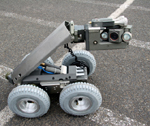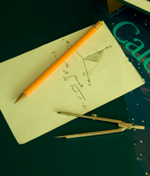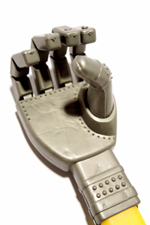How Is Geometry Used In Robotics
In that location is lots of maths in robots! Retrieve of well-nigh any of the clever things robots tin can do, its maths that makes it happen.
Turn left?
 A robot works its style round a room, it's using sensors, and whether they are ultrasonic, or detecting calorie-free or even smells, the sensors plow their measurement of the outside globe into numbers, and numbers means maths. For example to avert hitting something in its path a robot monitors the numbers coming from the ultrasonic detector, similar a bat sending out a chirp, the signal bounced off the obstruction comes back, and the robot calculates the altitude to the obstruction. Speed equals distance divided past time, and so if the robot knows how fast its ultrasonic 'ping' is moving it tin can calculate the distance the ping has travelled over if it knows the fourth dimension delay, and from this it knows how far the object is abroad. If the object is likewise close, the robot can just turn its wheels and motility away, collision avoided.
A robot works its style round a room, it's using sensors, and whether they are ultrasonic, or detecting calorie-free or even smells, the sensors plow their measurement of the outside globe into numbers, and numbers means maths. For example to avert hitting something in its path a robot monitors the numbers coming from the ultrasonic detector, similar a bat sending out a chirp, the signal bounced off the obstruction comes back, and the robot calculates the altitude to the obstruction. Speed equals distance divided past time, and so if the robot knows how fast its ultrasonic 'ping' is moving it tin can calculate the distance the ping has travelled over if it knows the fourth dimension delay, and from this it knows how far the object is abroad. If the object is likewise close, the robot can just turn its wheels and motility away, collision avoided.
Grab that cuppa
 A robot hand reaches out to pick up a loving cup of tea. Maths again, if the arm has a articulation, similar a man arm with an elbow, the position of the robots mitt, or grasper, is adamant by the angles at the joints of the arm, and the length of the sections of the arm. Using good onetime trigonometry you can work out for a given robot arm length and given angles at the joint, where the gripper will exist. That's useful, merely what the robot needs to summate is the inverse problem, it wants to put its gripper at a particular point in space, for example where the cuppa is, and so how should it angle the joints to allow this? This is the maths of inverse kinematics. If yous think almost it (endeavor it with your arm) at that place are a number of ways the arm could be flexed and still have the gripper (hand) at the aforementioned position. The more joints you lot have, elbow, shoulder and wrist (these are chosen degrees of freedom) the more hard the maths becomes simply the more flexible the robots abilities become. There are a whole range of clever maths tricks that have been used to solve this inverse trouble, and today'southward robots can reach out and grab thanks to mathematicians.
A robot hand reaches out to pick up a loving cup of tea. Maths again, if the arm has a articulation, similar a man arm with an elbow, the position of the robots mitt, or grasper, is adamant by the angles at the joints of the arm, and the length of the sections of the arm. Using good onetime trigonometry you can work out for a given robot arm length and given angles at the joint, where the gripper will exist. That's useful, merely what the robot needs to summate is the inverse problem, it wants to put its gripper at a particular point in space, for example where the cuppa is, and so how should it angle the joints to allow this? This is the maths of inverse kinematics. If yous think almost it (endeavor it with your arm) at that place are a number of ways the arm could be flexed and still have the gripper (hand) at the aforementioned position. The more joints you lot have, elbow, shoulder and wrist (these are chosen degrees of freedom) the more hard the maths becomes simply the more flexible the robots abilities become. There are a whole range of clever maths tricks that have been used to solve this inverse trouble, and today'southward robots can reach out and grab thanks to mathematicians.
Getting smarter
 Ane of the most interesting areas of robotics is the ability to learn. If a robot can learn how to do a task then it doesn't demand to exist told every time exactly what to exercise. Humans acquire all the time, our brains are biological learning machines, each time we try something new connections in our encephalon change and, over time, we become meliorate at the task. Think about reading, you couldn't read when you lot were a infant, but your learned. How? Well y'all beginning learned what messages wait like. Robots can do this, presented with lots of unlike letter a's for instance, each written in a dissimilar handwriting, a robot can utilize statistics to work out what the average shape of a letter of the alphabet a is. Ok and so it needs a teachers to say this is an a, or this is a b, but you needed a instructor too. After the robot has learned what the average shape if letters are, if it and so sees, with its camera, a new letter it tin can attempt and friction match the new letter of the alphabet to one of the learned letters. And then tin start to read. The aforementioned trick works with other objects, recognising faces for example, or the expressions on peoples faces. Having been showed lots of examples the mathematics is able to pull out the patterns that mean, for example it's a confront rather than furniture. This is the basis of motorcar number plate recognition for congestion charging, the computers has learned the shapes of the letters and numbers.
Ane of the most interesting areas of robotics is the ability to learn. If a robot can learn how to do a task then it doesn't demand to exist told every time exactly what to exercise. Humans acquire all the time, our brains are biological learning machines, each time we try something new connections in our encephalon change and, over time, we become meliorate at the task. Think about reading, you couldn't read when you lot were a infant, but your learned. How? Well y'all beginning learned what messages wait like. Robots can do this, presented with lots of unlike letter a's for instance, each written in a dissimilar handwriting, a robot can utilize statistics to work out what the average shape of a letter of the alphabet a is. Ok and so it needs a teachers to say this is an a, or this is a b, but you needed a instructor too. After the robot has learned what the average shape if letters are, if it and so sees, with its camera, a new letter it tin can attempt and friction match the new letter of the alphabet to one of the learned letters. And then tin start to read. The aforementioned trick works with other objects, recognising faces for example, or the expressions on peoples faces. Having been showed lots of examples the mathematics is able to pull out the patterns that mean, for example it's a confront rather than furniture. This is the basis of motorcar number plate recognition for congestion charging, the computers has learned the shapes of the letters and numbers.
Seeing and doing
Robots take in sensory information, from their cameras, ultrasonic and so on, and so practise something with that information. They acquit sensibly, they avoid a wall or recognise a grinning face up and movement towards it. Doing something means moving a role of the robot in the correct way, the technical term for this is a motor response (motor here doesn't refer to an electric motor, but to an actual movement of a function of the robot). Robots can therefore exist seen as sensory-motor machines, they detect something (sensory) and react to it (motor). In fact humans are just very complicated sensory-motor machines; we tin decide how we respond to particular sensory signals from the world around us. Our brain contains whole areas given over to processing information from our eyes or ears or the touch sensors on our skin. These areas then link with so called motor cortex, this is the function of our brain that causes our muscles to move, and our muscles moving are our motors responses. Maths is helping us understand the way our brains work, computational neuroscientists work on developing mathematical descriptions of how those parts of our brains work and interact, it's a fascinating fusion of maths, biology and psychology.
Punk robots
A proficient example of this sensory- motor machine thought, combined with robot learning, are the punk robots that were built to be part of the audition at punk stone gigs. Punk rockers beloved to dance, and their trip the light fantastic of pick is the pogo, jumping upwards and downward in fourth dimension to the music. Then our punk robots pogo on computer controlled pistons, their motor response is to pogo, either minor jumps or bang-up big jumps. What makes them pogo, well it's the music. The robots learned how to recognise good punk music. To exercise this Fiddian, who was the lead vocaliser in the punk band Neurotic, used his record collection. Every bit a child he was really into punk, then the reckoner listened to all his old punk records and then using some clever maths and statistics based on ideas from the man brain, information technology was able to discover the sorts of musical patterns that were in punk music. The estimator also listened to classical music, disco, pop, RnB, house, trance and so on, in fact a whole load of musical types. It was so taught that punk was best, so when it hears a new piece of music it listens to see how punky it is, how exercise the patterns in the music match up to the patterns in the punk its listened to before. The closer the lucifer to the music it loves, the bigger the punkiness signal information technology creates. That punkiness indicate then controls the pogoing, a better lucifer gives a bigger pogo.
All together now
The robots are listening to a live band, and live bands can alter the way they play. When Fiddian was playing it was like entertaining uncomplicated robot copies of himself every bit a punk loving kid. He then tried to perform better to brand the robots pogo more, so he and the robots were joined together, the robots behaviour influence the style that Fiddian performs, and they way he performs changes the way that the robots pogos. The pogoing robots likewise influence other people in the audience, and frequently humans would start to pogo when the robots did. This is something called social feedback, what nosotros exercise influences they ways others act which in turn influences the fashion we deed. There are even mathematical models for this sort of grouping behaviours, and they tin be used to help robots go improve in social situations, after all if they are going to exist our friends in the time to come they demand to know how to behave properly. Merely perhaps the punk robots are the rebellious adolescents of robotics, just interested in music, moshing and maths.
Article by Professor Peter McOwan, Professor of Calculator Science, Queen Mary, University of London
How Is Geometry Used In Robotics,
Source: https://www.mathscareers.org.uk/maths-within-robots/
Posted by: marquezgraime.blogspot.com


0 Response to "How Is Geometry Used In Robotics"
Post a Comment